Relationship Between Roach's 6Cs Caring Theory and NMBA Nursing Codes
VerifiedAdded on 2022/09/14
|6
|1385
|12
Essay
AI Summary
This essay provides a critical analysis of the relationship between Simone Roach's 6Cs caring theory and the Nursing and Midwifery Board of Australia (NMBA) codes of conduct. The essay explores the core attributes of Roach's theory, including compassion, competence, conscience, confidence, commitment, and comportment, and examines how these attributes align with and support the principles outlined in the NMBA codes. It emphasizes the significance of compassion and commitment in promoting person-centered care, professional behavior, and cultural sensitivity, particularly in the context of Aboriginal and Torres Strait Islander healthcare. The essay highlights how nurses can maintain professional boundaries, uphold legal compliance, and contribute to improved patient outcomes through the application of Roach's 6Cs theory. The essay also discusses the role of commitment in nursing research and the development of improved service policies and professional codes.
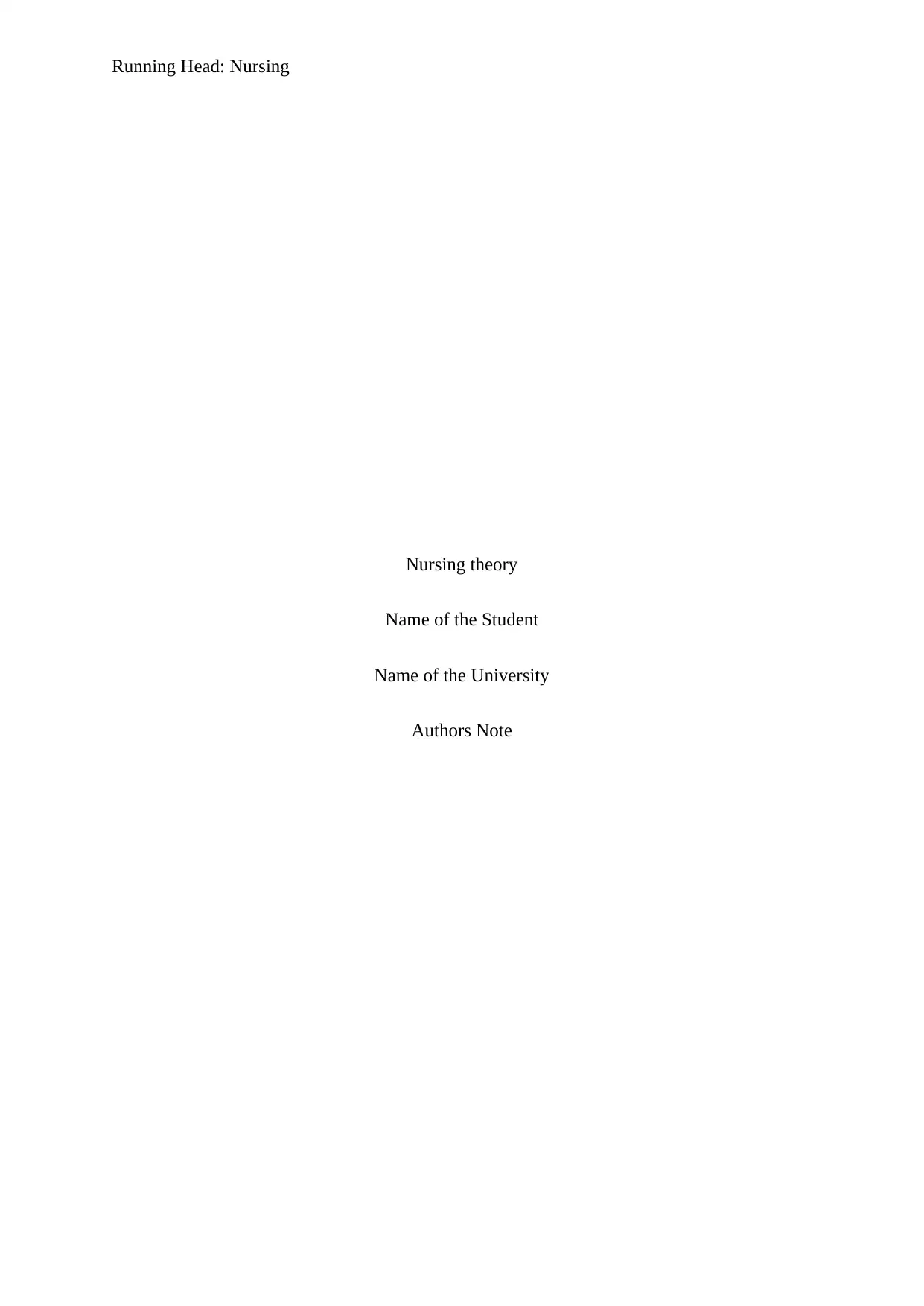
Running Head: Nursing
Nursing theory
Name of the Student
Name of the University
Authors Note
Nursing theory
Name of the Student
Name of the University
Authors Note
Paraphrase This Document
Need a fresh take? Get an instant paraphrase of this document with our AI Paraphraser
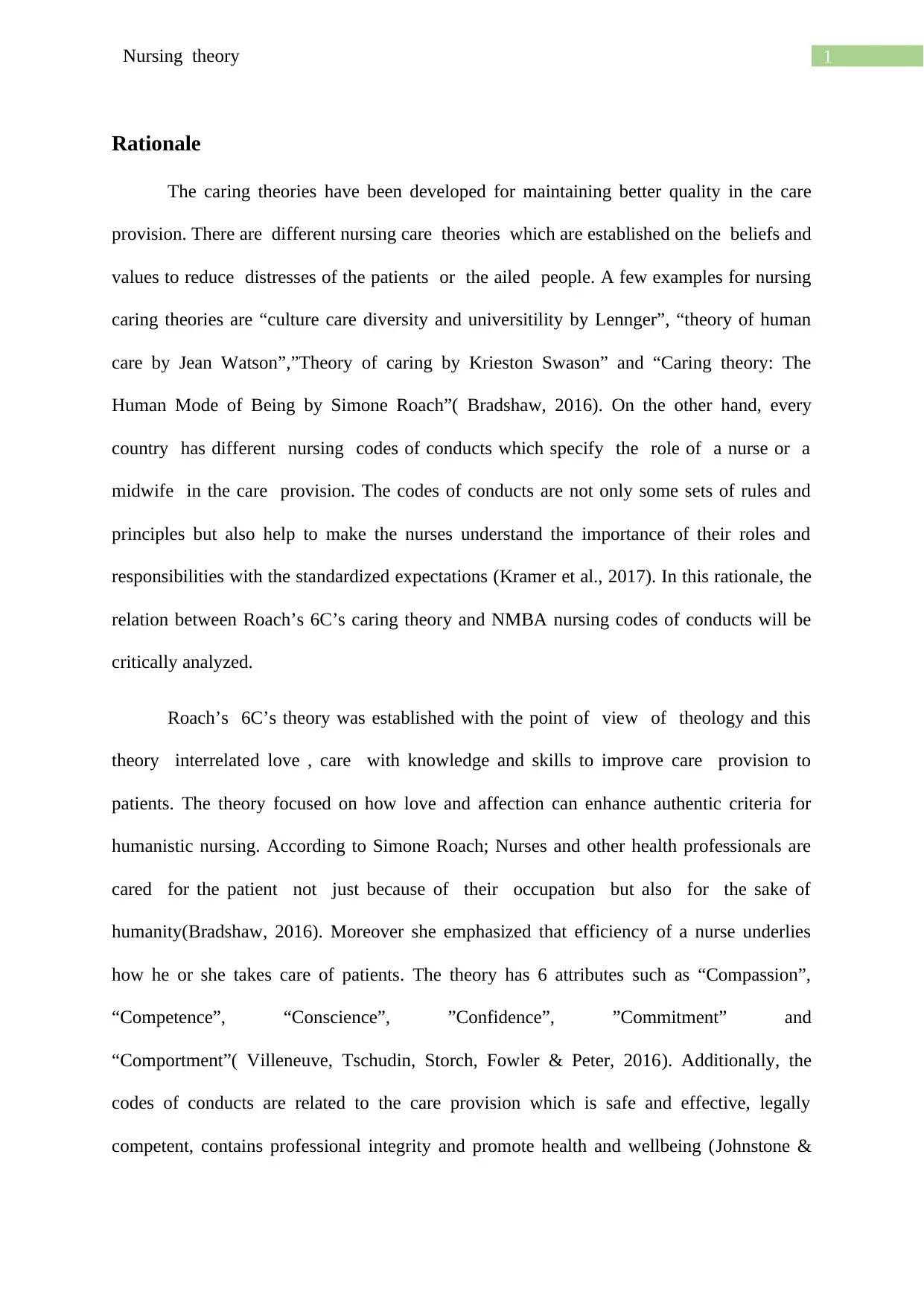
1Nursing theory
Rationale
The caring theories have been developed for maintaining better quality in the care
provision. There are different nursing care theories which are established on the beliefs and
values to reduce distresses of the patients or the ailed people. A few examples for nursing
caring theories are “culture care diversity and universitility by Lennger”, “theory of human
care by Jean Watson”,”Theory of caring by Krieston Swason” and “Caring theory: The
Human Mode of Being by Simone Roach”( Bradshaw, 2016). On the other hand, every
country has different nursing codes of conducts which specify the role of a nurse or a
midwife in the care provision. The codes of conducts are not only some sets of rules and
principles but also help to make the nurses understand the importance of their roles and
responsibilities with the standardized expectations (Kramer et al., 2017). In this rationale, the
relation between Roach’s 6C’s caring theory and NMBA nursing codes of conducts will be
critically analyzed.
Roach’s 6C’s theory was established with the point of view of theology and this
theory interrelated love , care with knowledge and skills to improve care provision to
patients. The theory focused on how love and affection can enhance authentic criteria for
humanistic nursing. According to Simone Roach; Nurses and other health professionals are
cared for the patient not just because of their occupation but also for the sake of
humanity(Bradshaw, 2016). Moreover she emphasized that efficiency of a nurse underlies
how he or she takes care of patients. The theory has 6 attributes such as “Compassion”,
“Competence”, “Conscience”, ”Confidence”, ”Commitment” and
“Comportment”( Villeneuve, Tschudin, Storch, Fowler & Peter, 2016). Additionally, the
codes of conducts are related to the care provision which is safe and effective, legally
competent, contains professional integrity and promote health and wellbeing (Johnstone &
Rationale
The caring theories have been developed for maintaining better quality in the care
provision. There are different nursing care theories which are established on the beliefs and
values to reduce distresses of the patients or the ailed people. A few examples for nursing
caring theories are “culture care diversity and universitility by Lennger”, “theory of human
care by Jean Watson”,”Theory of caring by Krieston Swason” and “Caring theory: The
Human Mode of Being by Simone Roach”( Bradshaw, 2016). On the other hand, every
country has different nursing codes of conducts which specify the role of a nurse or a
midwife in the care provision. The codes of conducts are not only some sets of rules and
principles but also help to make the nurses understand the importance of their roles and
responsibilities with the standardized expectations (Kramer et al., 2017). In this rationale, the
relation between Roach’s 6C’s caring theory and NMBA nursing codes of conducts will be
critically analyzed.
Roach’s 6C’s theory was established with the point of view of theology and this
theory interrelated love , care with knowledge and skills to improve care provision to
patients. The theory focused on how love and affection can enhance authentic criteria for
humanistic nursing. According to Simone Roach; Nurses and other health professionals are
cared for the patient not just because of their occupation but also for the sake of
humanity(Bradshaw, 2016). Moreover she emphasized that efficiency of a nurse underlies
how he or she takes care of patients. The theory has 6 attributes such as “Compassion”,
“Competence”, “Conscience”, ”Confidence”, ”Commitment” and
“Comportment”( Villeneuve, Tschudin, Storch, Fowler & Peter, 2016). Additionally, the
codes of conducts are related to the care provision which is safe and effective, legally
competent, contains professional integrity and promote health and wellbeing (Johnstone &
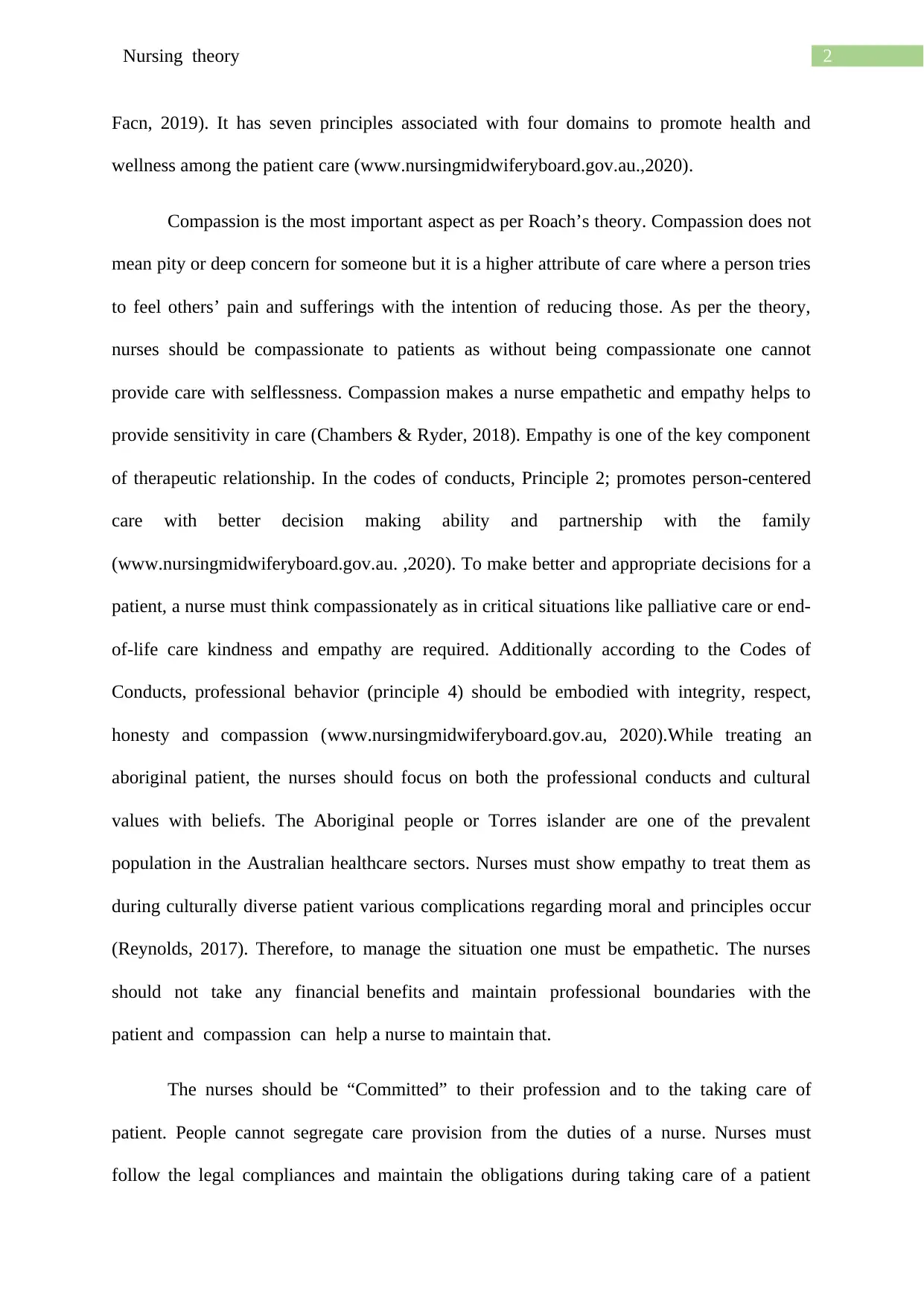
2Nursing theory
Facn, 2019). It has seven principles associated with four domains to promote health and
wellness among the patient care (www.nursingmidwiferyboard.gov.au.,2020).
Compassion is the most important aspect as per Roach’s theory. Compassion does not
mean pity or deep concern for someone but it is a higher attribute of care where a person tries
to feel others’ pain and sufferings with the intention of reducing those. As per the theory,
nurses should be compassionate to patients as without being compassionate one cannot
provide care with selflessness. Compassion makes a nurse empathetic and empathy helps to
provide sensitivity in care (Chambers & Ryder, 2018). Empathy is one of the key component
of therapeutic relationship. In the codes of conducts, Principle 2; promotes person-centered
care with better decision making ability and partnership with the family
(www.nursingmidwiferyboard.gov.au. ,2020). To make better and appropriate decisions for a
patient, a nurse must think compassionately as in critical situations like palliative care or end-
of-life care kindness and empathy are required. Additionally according to the Codes of
Conducts, professional behavior (principle 4) should be embodied with integrity, respect,
honesty and compassion (www.nursingmidwiferyboard.gov.au, 2020).While treating an
aboriginal patient, the nurses should focus on both the professional conducts and cultural
values with beliefs. The Aboriginal people or Torres islander are one of the prevalent
population in the Australian healthcare sectors. Nurses must show empathy to treat them as
during culturally diverse patient various complications regarding moral and principles occur
(Reynolds, 2017). Therefore, to manage the situation one must be empathetic. The nurses
should not take any financial benefits and maintain professional boundaries with the
patient and compassion can help a nurse to maintain that.
The nurses should be “Committed” to their profession and to the taking care of
patient. People cannot segregate care provision from the duties of a nurse. Nurses must
follow the legal compliances and maintain the obligations during taking care of a patient
Facn, 2019). It has seven principles associated with four domains to promote health and
wellness among the patient care (www.nursingmidwiferyboard.gov.au.,2020).
Compassion is the most important aspect as per Roach’s theory. Compassion does not
mean pity or deep concern for someone but it is a higher attribute of care where a person tries
to feel others’ pain and sufferings with the intention of reducing those. As per the theory,
nurses should be compassionate to patients as without being compassionate one cannot
provide care with selflessness. Compassion makes a nurse empathetic and empathy helps to
provide sensitivity in care (Chambers & Ryder, 2018). Empathy is one of the key component
of therapeutic relationship. In the codes of conducts, Principle 2; promotes person-centered
care with better decision making ability and partnership with the family
(www.nursingmidwiferyboard.gov.au. ,2020). To make better and appropriate decisions for a
patient, a nurse must think compassionately as in critical situations like palliative care or end-
of-life care kindness and empathy are required. Additionally according to the Codes of
Conducts, professional behavior (principle 4) should be embodied with integrity, respect,
honesty and compassion (www.nursingmidwiferyboard.gov.au, 2020).While treating an
aboriginal patient, the nurses should focus on both the professional conducts and cultural
values with beliefs. The Aboriginal people or Torres islander are one of the prevalent
population in the Australian healthcare sectors. Nurses must show empathy to treat them as
during culturally diverse patient various complications regarding moral and principles occur
(Reynolds, 2017). Therefore, to manage the situation one must be empathetic. The nurses
should not take any financial benefits and maintain professional boundaries with the
patient and compassion can help a nurse to maintain that.
The nurses should be “Committed” to their profession and to the taking care of
patient. People cannot segregate care provision from the duties of a nurse. Nurses must
follow the legal compliances and maintain the obligations during taking care of a patient
⊘ This is a preview!⊘
Do you want full access?
Subscribe today to unlock all pages.

Trusted by 1+ million students worldwide
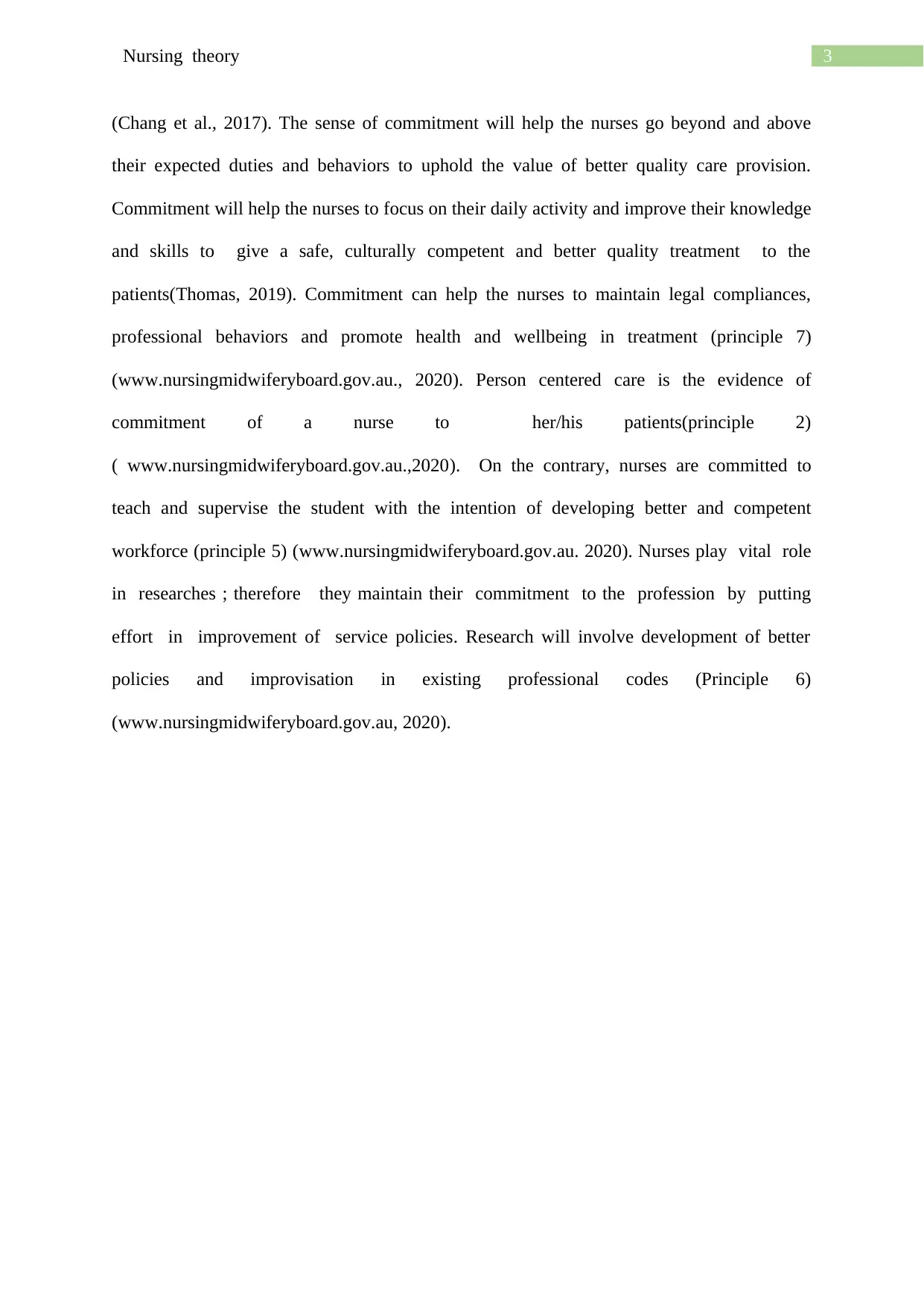
3Nursing theory
(Chang et al., 2017). The sense of commitment will help the nurses go beyond and above
their expected duties and behaviors to uphold the value of better quality care provision.
Commitment will help the nurses to focus on their daily activity and improve their knowledge
and skills to give a safe, culturally competent and better quality treatment to the
patients(Thomas, 2019). Commitment can help the nurses to maintain legal compliances,
professional behaviors and promote health and wellbeing in treatment (principle 7)
(www.nursingmidwiferyboard.gov.au., 2020). Person centered care is the evidence of
commitment of a nurse to her/his patients(principle 2)
( www.nursingmidwiferyboard.gov.au.,2020). On the contrary, nurses are committed to
teach and supervise the student with the intention of developing better and competent
workforce (principle 5) (www.nursingmidwiferyboard.gov.au. 2020). Nurses play vital role
in researches ; therefore they maintain their commitment to the profession by putting
effort in improvement of service policies. Research will involve development of better
policies and improvisation in existing professional codes (Principle 6)
(www.nursingmidwiferyboard.gov.au, 2020).
(Chang et al., 2017). The sense of commitment will help the nurses go beyond and above
their expected duties and behaviors to uphold the value of better quality care provision.
Commitment will help the nurses to focus on their daily activity and improve their knowledge
and skills to give a safe, culturally competent and better quality treatment to the
patients(Thomas, 2019). Commitment can help the nurses to maintain legal compliances,
professional behaviors and promote health and wellbeing in treatment (principle 7)
(www.nursingmidwiferyboard.gov.au., 2020). Person centered care is the evidence of
commitment of a nurse to her/his patients(principle 2)
( www.nursingmidwiferyboard.gov.au.,2020). On the contrary, nurses are committed to
teach and supervise the student with the intention of developing better and competent
workforce (principle 5) (www.nursingmidwiferyboard.gov.au. 2020). Nurses play vital role
in researches ; therefore they maintain their commitment to the profession by putting
effort in improvement of service policies. Research will involve development of better
policies and improvisation in existing professional codes (Principle 6)
(www.nursingmidwiferyboard.gov.au, 2020).
Paraphrase This Document
Need a fresh take? Get an instant paraphrase of this document with our AI Paraphraser
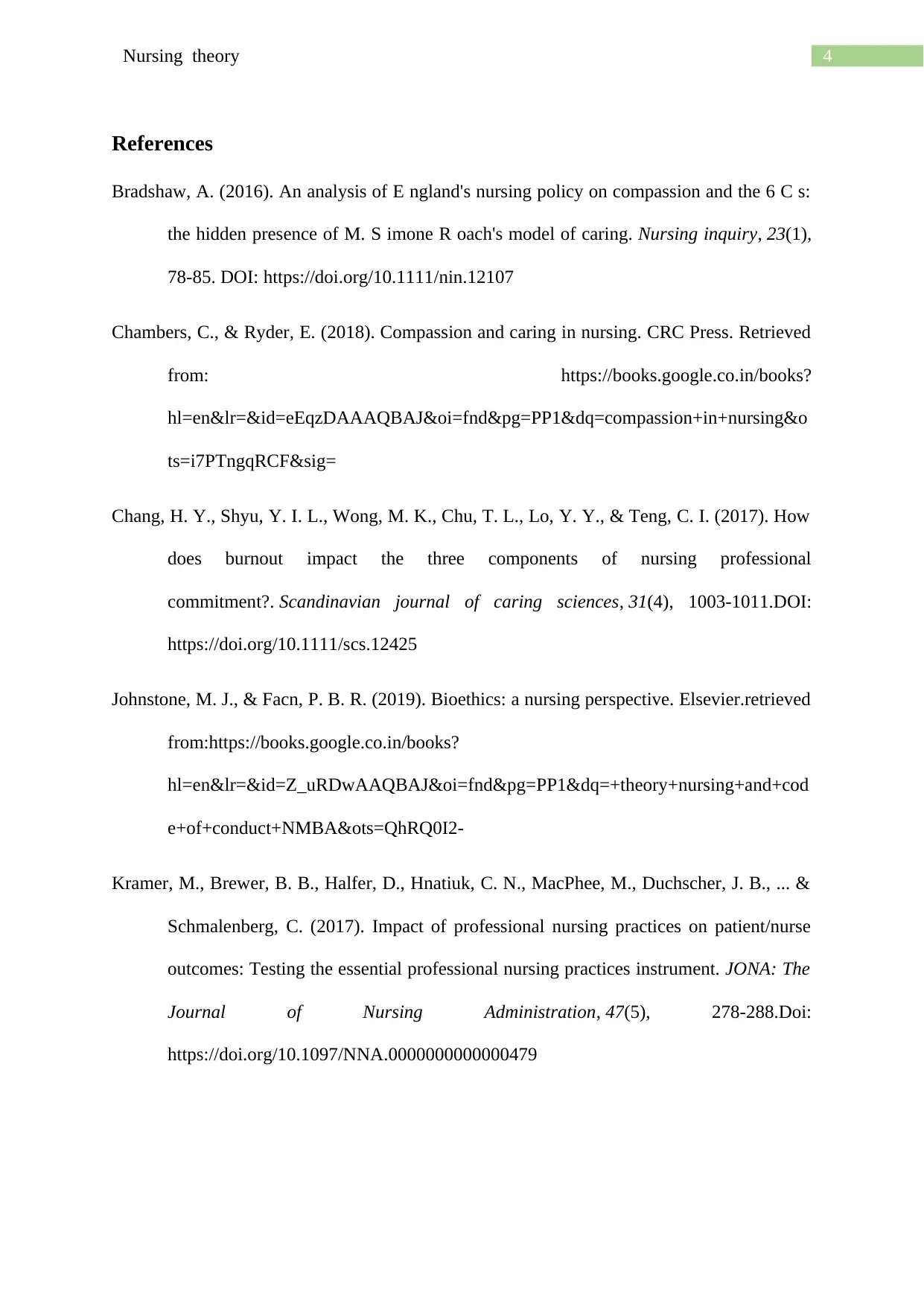
4Nursing theory
References
Bradshaw, A. (2016). An analysis of E ngland's nursing policy on compassion and the 6 C s:
the hidden presence of M. S imone R oach's model of caring. Nursing inquiry, 23(1),
78-85. DOI: https://doi.org/10.1111/nin.12107
Chambers, C., & Ryder, E. (2018). Compassion and caring in nursing. CRC Press. Retrieved
from: https://books.google.co.in/books?
hl=en&lr=&id=eEqzDAAAQBAJ&oi=fnd&pg=PP1&dq=compassion+in+nursing&o
ts=i7PTngqRCF&sig=
Chang, H. Y., Shyu, Y. I. L., Wong, M. K., Chu, T. L., Lo, Y. Y., & Teng, C. I. (2017). How
does burnout impact the three components of nursing professional
commitment?. Scandinavian journal of caring sciences, 31(4), 1003-1011.DOI:
https://doi.org/10.1111/scs.12425
Johnstone, M. J., & Facn, P. B. R. (2019). Bioethics: a nursing perspective. Elsevier.retrieved
from:https://books.google.co.in/books?
hl=en&lr=&id=Z_uRDwAAQBAJ&oi=fnd&pg=PP1&dq=+theory+nursing+and+cod
e+of+conduct+NMBA&ots=QhRQ0I2-
Kramer, M., Brewer, B. B., Halfer, D., Hnatiuk, C. N., MacPhee, M., Duchscher, J. B., ... &
Schmalenberg, C. (2017). Impact of professional nursing practices on patient/nurse
outcomes: Testing the essential professional nursing practices instrument. JONA: The
Journal of Nursing Administration, 47(5), 278-288.Doi:
https://doi.org/10.1097/NNA.0000000000000479
References
Bradshaw, A. (2016). An analysis of E ngland's nursing policy on compassion and the 6 C s:
the hidden presence of M. S imone R oach's model of caring. Nursing inquiry, 23(1),
78-85. DOI: https://doi.org/10.1111/nin.12107
Chambers, C., & Ryder, E. (2018). Compassion and caring in nursing. CRC Press. Retrieved
from: https://books.google.co.in/books?
hl=en&lr=&id=eEqzDAAAQBAJ&oi=fnd&pg=PP1&dq=compassion+in+nursing&o
ts=i7PTngqRCF&sig=
Chang, H. Y., Shyu, Y. I. L., Wong, M. K., Chu, T. L., Lo, Y. Y., & Teng, C. I. (2017). How
does burnout impact the three components of nursing professional
commitment?. Scandinavian journal of caring sciences, 31(4), 1003-1011.DOI:
https://doi.org/10.1111/scs.12425
Johnstone, M. J., & Facn, P. B. R. (2019). Bioethics: a nursing perspective. Elsevier.retrieved
from:https://books.google.co.in/books?
hl=en&lr=&id=Z_uRDwAAQBAJ&oi=fnd&pg=PP1&dq=+theory+nursing+and+cod
e+of+conduct+NMBA&ots=QhRQ0I2-
Kramer, M., Brewer, B. B., Halfer, D., Hnatiuk, C. N., MacPhee, M., Duchscher, J. B., ... &
Schmalenberg, C. (2017). Impact of professional nursing practices on patient/nurse
outcomes: Testing the essential professional nursing practices instrument. JONA: The
Journal of Nursing Administration, 47(5), 278-288.Doi:
https://doi.org/10.1097/NNA.0000000000000479
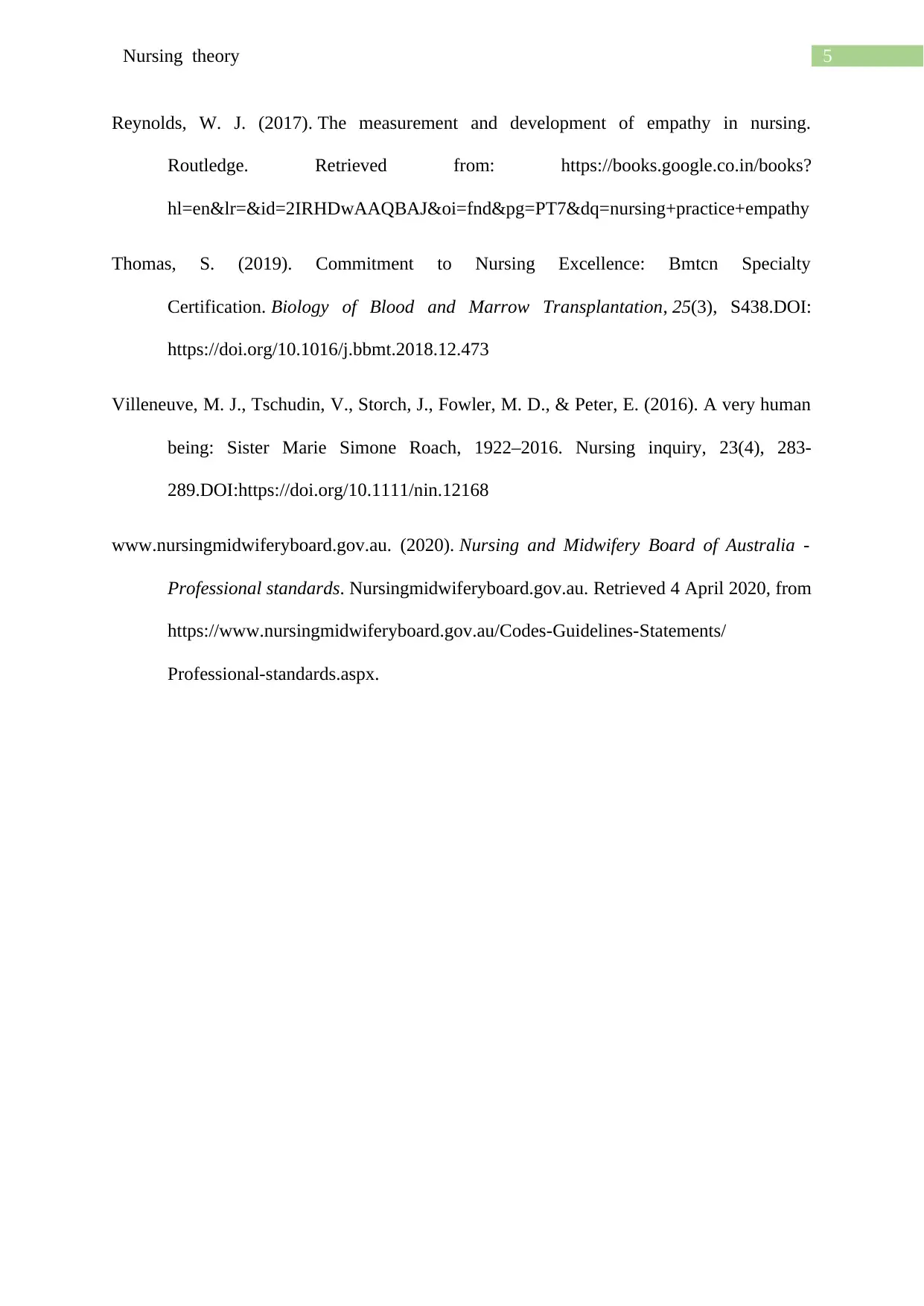
5Nursing theory
Reynolds, W. J. (2017). The measurement and development of empathy in nursing.
Routledge. Retrieved from: https://books.google.co.in/books?
hl=en&lr=&id=2IRHDwAAQBAJ&oi=fnd&pg=PT7&dq=nursing+practice+empathy
Thomas, S. (2019). Commitment to Nursing Excellence: Bmtcn Specialty
Certification. Biology of Blood and Marrow Transplantation, 25(3), S438.DOI:
https://doi.org/10.1016/j.bbmt.2018.12.473
Villeneuve, M. J., Tschudin, V., Storch, J., Fowler, M. D., & Peter, E. (2016). A very human
being: Sister Marie Simone Roach, 1922–2016. Nursing inquiry, 23(4), 283-
289.DOI:https://doi.org/10.1111/nin.12168
www.nursingmidwiferyboard.gov.au. (2020). Nursing and Midwifery Board of Australia -
Professional standards. Nursingmidwiferyboard.gov.au. Retrieved 4 April 2020, from
https://www.nursingmidwiferyboard.gov.au/Codes-Guidelines-Statements/
Professional-standards.aspx.
Reynolds, W. J. (2017). The measurement and development of empathy in nursing.
Routledge. Retrieved from: https://books.google.co.in/books?
hl=en&lr=&id=2IRHDwAAQBAJ&oi=fnd&pg=PT7&dq=nursing+practice+empathy
Thomas, S. (2019). Commitment to Nursing Excellence: Bmtcn Specialty
Certification. Biology of Blood and Marrow Transplantation, 25(3), S438.DOI:
https://doi.org/10.1016/j.bbmt.2018.12.473
Villeneuve, M. J., Tschudin, V., Storch, J., Fowler, M. D., & Peter, E. (2016). A very human
being: Sister Marie Simone Roach, 1922–2016. Nursing inquiry, 23(4), 283-
289.DOI:https://doi.org/10.1111/nin.12168
www.nursingmidwiferyboard.gov.au. (2020). Nursing and Midwifery Board of Australia -
Professional standards. Nursingmidwiferyboard.gov.au. Retrieved 4 April 2020, from
https://www.nursingmidwiferyboard.gov.au/Codes-Guidelines-Statements/
Professional-standards.aspx.
⊘ This is a preview!⊘
Do you want full access?
Subscribe today to unlock all pages.

Trusted by 1+ million students worldwide
1 out of 6
Related Documents
Your All-in-One AI-Powered Toolkit for Academic Success.
+13062052269
info@desklib.com
Available 24*7 on WhatsApp / Email
![[object Object]](/_next/static/media/star-bottom.7253800d.svg)
Unlock your academic potential
Copyright © 2020–2025 A2Z Services. All Rights Reserved. Developed and managed by ZUCOL.





